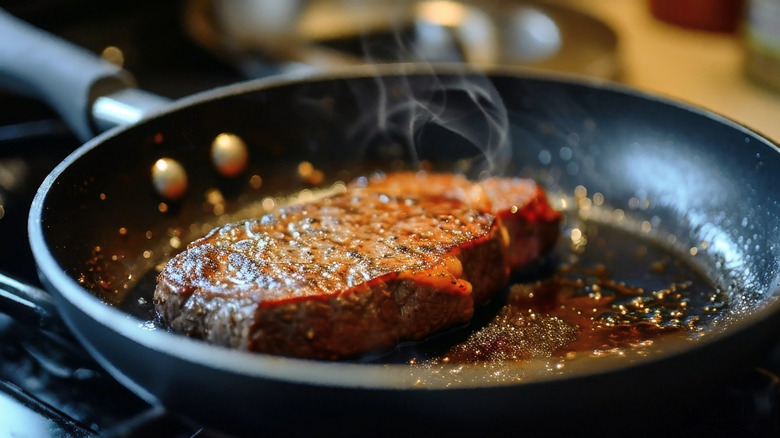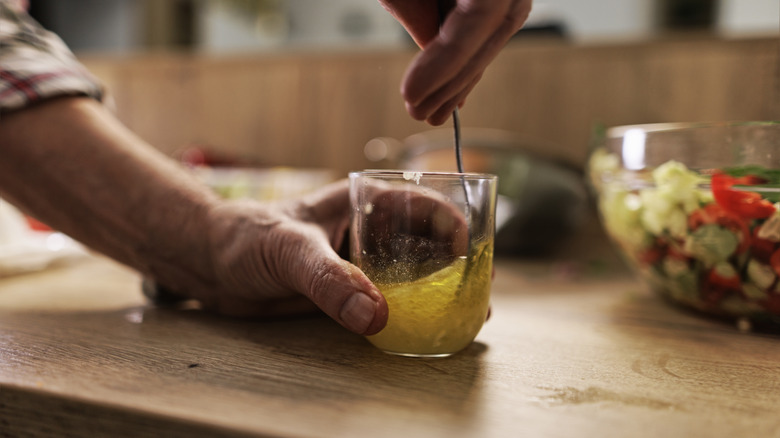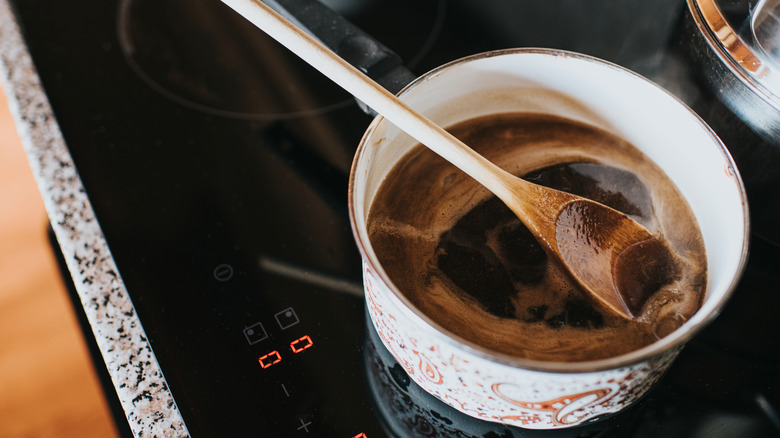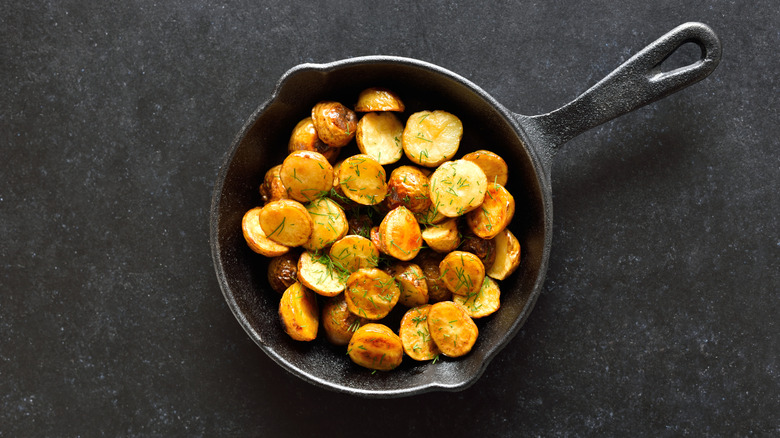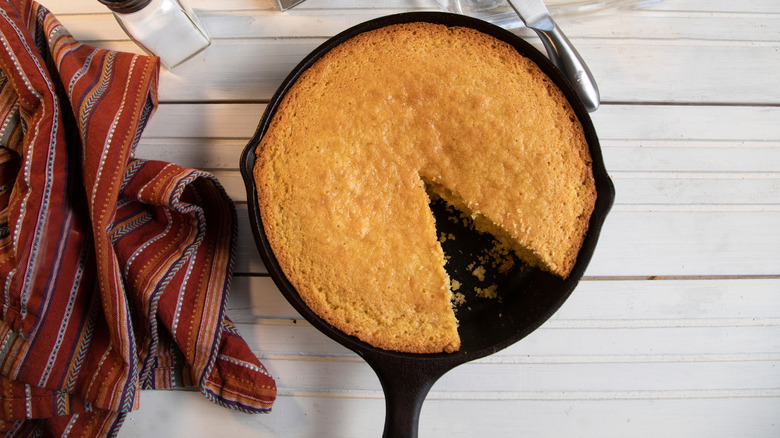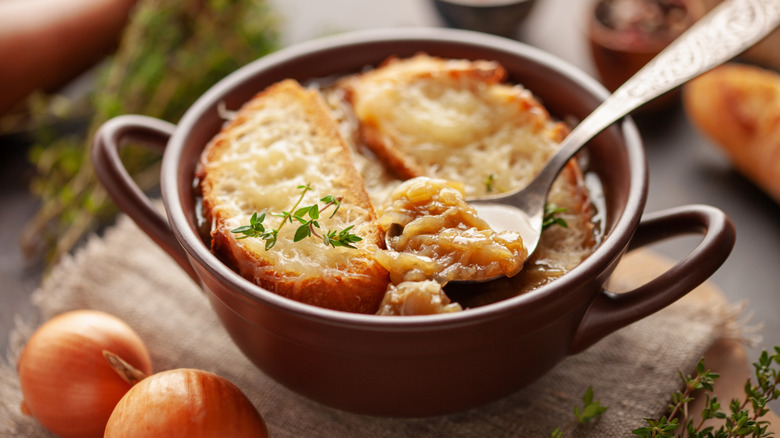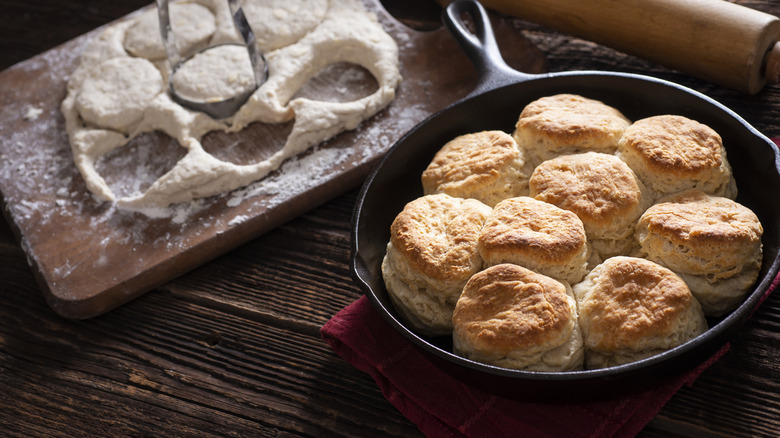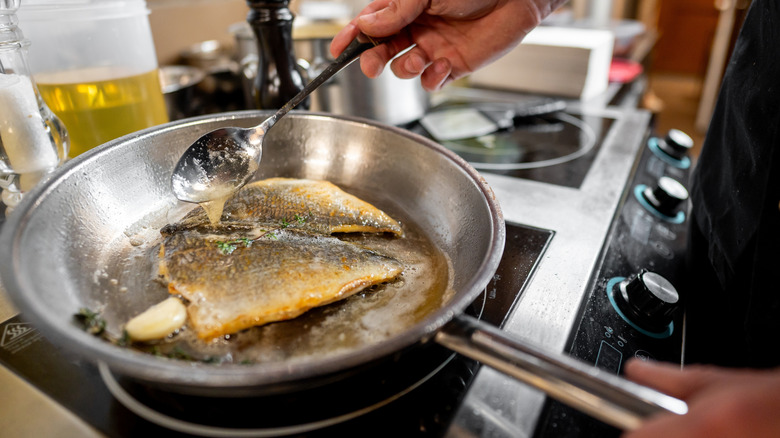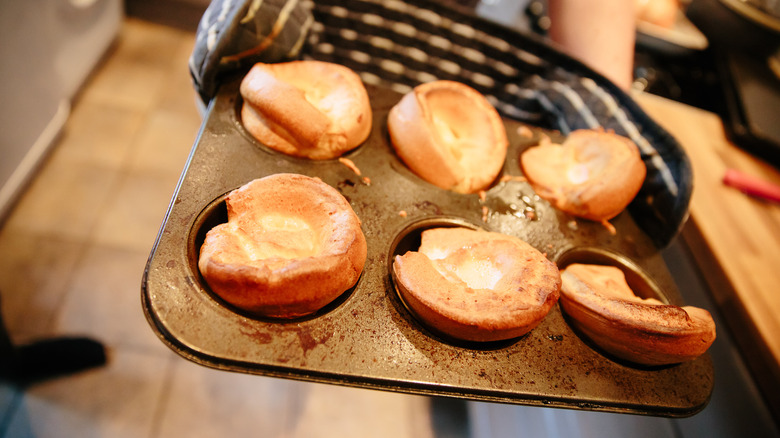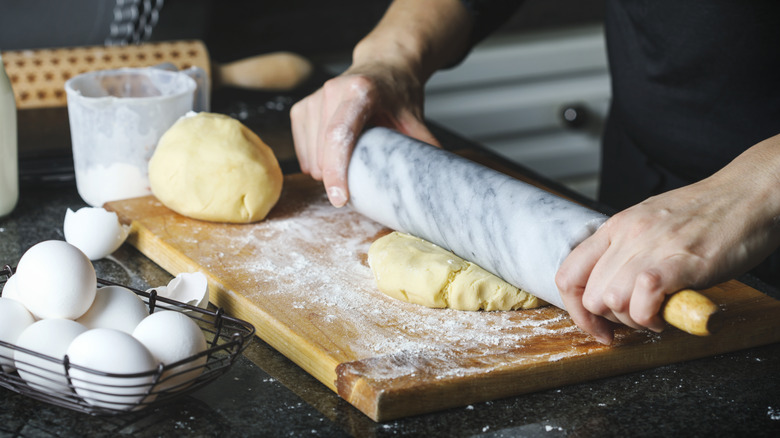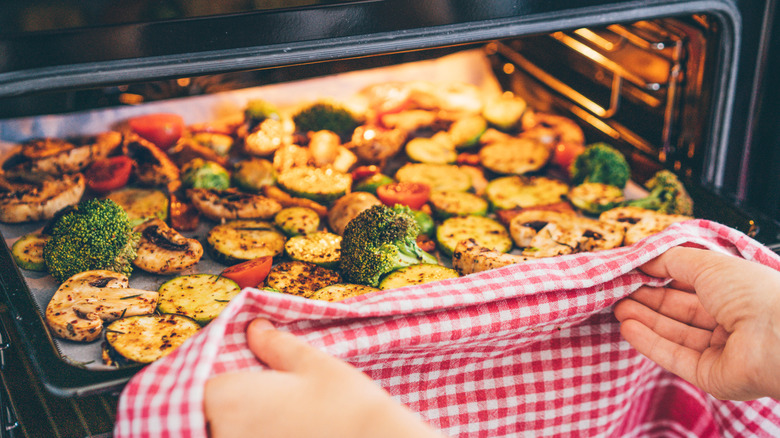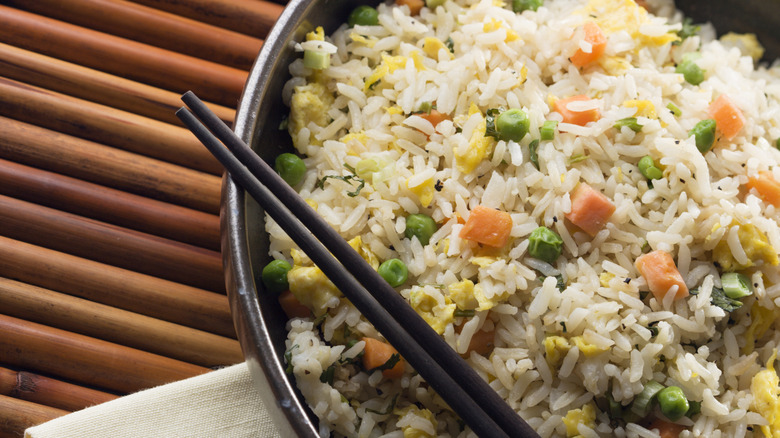13 Delicious Uses For Leftover Steak Fat
There's no denying that a well-cooked steak makes a delicious meal. And luckily, it's also the gift that keeps on giving. The remaining steak fat is a versatile byproduct that can be used in nearly endless applications in the kitchen to enhance everyday dishes from biscuits to fried rice.
While you can use the beef fat straight from the pan, you can also render it into beef tallow for an even more versatile kitchen staple. This semi-solid fat is similar to lard and butter, making it perfect for greasing a pan, using in baked goods, or enhancing the flavors of your favorite dishes. To make tallow, simply cut up the beef fat, add salt and water, and render the fat low and slow for up to 12 hours.
Once done, the liquid tallow will rise to the top. After it has separated, strain the liquid tallow from the remnants. After it has solidified, it will quickly become your newest kitchen staple. Discover the best ways to use leftover steak fat and beef tallow to add rich, beefy flavor to almost any meal.
1. Mix up a warm vinaigrette
While your steak fat is still hot in the pan, consider using it as the fat in a delicious vinaigrette in place of oil like extra-virgin olive oil or canola oil. Common ingredients used in steak fat vinaigrettes include shallots, garlic, and herbs like parsley or thyme, but you can mix and match whatever ingredients you like.
First, sauté everything in the beef fat over low heat for a few minutes to blend all of the flavors. Remove from heat and pour over your steak for an added burst of flavor. You could also add the steak on top of your favorite simple salad and use the vinaigrette as a dressing to get more veggies into your meal — without sacrificing flavor.
If you have a little extra time, you can also infuse the steak fat with garlic and herbs over low heat for about 30 minutes to turn it into a more complex chimichurri sauce. Strain and mix with fresh herbs and other aromatics to create a delicious topping for your steak or vegetables.
2. Make gravy
The more savory, rich, and meaty the gravy, the better. And there's almost no better way to achieve that decadent taste than by using steak fat as your gravy base. After turning the leftover fat into beef tallow, make a roux by mixing the melted tallow with flour (usually, a roux would be made with butter instead).
Once the flour has been incorporated, add your broth and any additional herbs. Bring it to a boil and then lower it to a simmer, allowing the gravy to reduce to your desired thickness. You can also add a pat of butter at the very end to emulsify your gravy and create a thick, silky texture.
Once ready, you can use this gravy on almost anything. While it's typically found on top of proteins like steak or turkey, you can also use it on mashed potatoes, roasted vegetables, or any other side. You can even use it in the mornings to create unbeatable, savory breakfasts like biscuits and gravy or sausage and gravy over grits.
3. Pan-fry potatoes
Potatoes are a common side for steak thanks to their delicious, starchy flavor and unmatched versatility. And while classics like french fries or mashed potatoes are always on standby, why not experiment with a different preparation? Pan-frying potatoes in the leftover steak fat adds a richness and depth of flavor that is missing when you use other, less flavorful fats to prep your spuds.
The process is simple. Use the beef tallow like you would any other solid fat (like butter). Melt a few tablespoons of the tallow over low heat until it has liquified. Once the liquified tallow is sizzling, drop your potatoes in the pan and stir them to coat evenly. Let the potatoes cook over medium-low heat without stirring until a delicious golden-brown crust forms. Toss and repeat until all sides of the potatoes have the same crust and are fork-tender. Top with salt and your choice of spices or herbs, and serve.
4. Flavor your popcorn
Popcorn and butter is one of the culinary world's most iconic flavor pairings. And while there's nothing quite like the savory and salty taste of freshly popped popcorn slathered in melted butter, using steak fat instead is an unexpected way to amp up the flavor of your favorite snack.
Besides subbing beef tallow for butter, the process of making the popcorn is the same. Melt it on the stovetop over low heat, and add your popcorn kernels to a pot or pan. Once popped, top with a sprinkle of salt. The beef tallow adds a hint of beefy flavor that isn't overpowering — it's the perfect subtle twist.
If you don't want to pop your popcorn on the stovetop, you can also top microwaved popcorn with melted beef tallow to achieve the same flavor. Or, if you're feeling adventurous, you can pop your popcorn on the grill for a hint of smoke.
5. Use it in your cornbread
Cornbread is the perfect balance of savory and sweet. Ideal as a side for rich dishes like chili or crispy fried chicken, this Southern staple gets a major upgrade when you substitute beef tallow for butter or lard in your favorite recipe.
Because many cornbread recipes already call for lard — which is clarified fat from a pig instead of a cow — it's a very simple swap. You can use the same amount of beef tallow as you would lard because they share the a similar semi-solid consistency. Though the tallow won't dramatically change the flavor of the final product, it will add a subtle richness to the cornbread.
If you're looking for a more potent, beefy flavor, fry the cornbread batter in tallow to create another Southern classic: fried cornbread. Though more of a fritter than traditional cornbread, the addition of beef tallow in both the batter and in the pan ensures you double down on the rich, savory beef flavor.
6. Beef up your favorite soup (literally)
Soups are endlessly versatile. From vegetable-filled varieties like potato leek to classics like beef stew or French onion soup, the flavors span the spectrum from mellow and mild to rich and bold. No matter what soup recipe you're working on, swapping beef tallow for your other oils will introduce a savory, beefy undertone to your dish.
The most obvious flavor pairing is to incorporate beef tallow in beef broth-based soups, enhancing the existing flavor profile. But don't be afraid to use it in vegetable or chicken broth-based soups, too. The rich taste of the tallow works especially well in hearty soups like loaded baked potato, tortellini and sausage, or Tuscan white bean. When preparing your chosen soup, use a one-to-one substitution of melted tallow in place of any oil for a simple but impactful swap. The result is a delicious, savory soup that is even cozier.
7. Make crumbly, moist biscuits
Though many people have begun to stray away from lard in recipes because of the high levels of saturated fat, in some recipes, it's a must. To achieve the flaky, soft, and melt-in-your-mouth texture of a classic Southern biscuit, many recipes call for a generous amount of lard.
While lard has a flavorless taste akin to a neutral oil like vegetable oil, beef tallow has a rich, beefy flavor. Adding this in your biscuits in place of lard will infuse the biscuits with a deeper, more earthy taste.
Using beef tallow in place of lard is simple. Cut the tallow into the flour like you would with lard to create a crumbly, loose dough. Because tallow is slightly firmer than lard, though, you may have to work the dough a bit more than usual. Once your dough is ready, bake for about 10 to 15 minutes, depending on the recipe. Once out of the oven, you'll get to savor the soft, fluffy, bakery-style biscuits with rich, full-bodied flavor — all thanks to this simple swap.
8. Add a crisp crust and extra flavor to meat and fish
Before access to cooking oils like olive, vegetable, and canola was widespread, animal fats were commonly used in cooking — and steak fat was no exception. It's been used for decades past in the kitchen to pan-sear almost everything at one point or another — partially because, once rendered, beef tallow has a high smoke-point of 420 degrees Fahrenheit. This makes it a natural choice for searing, sautéing, or other cooking methods that require high heats. That, paired with its savory, beefy flavor, makes beef tallow perfect for cooking not only steak but all other proteins like pork, chicken, or even fish.
As the protein heats in the pan, the tallow will begin to caramelize and add a delicious, savory crust to the exterior. This happens because of the Maillard reaction, which causes the amino acids and sugars in the tallow to brown. The chemical process not only changes the color of the dish, but also enhances the flavor and the end result is a crispy, rich, delicious dish.
9. Make classic Yorkshire pudding
No British Sunday roast is complete without the addition of classic Yorkshire pudding. Though contrary to what the name suggests, this "pudding" is a far cry from the chocolate or vanilla dessert most Americans associate with the word. The baked side dish is akin to a popover, and often served alongside roast beef or other English classics like bangers and mash.
The basic batter is made from flour, water, and eggs, almost similar to a pancake batter. Here's where things get interesting; before adding the batter to the pan, you'll want to pour steak fat or melted beef tallow into the pan and let it heat up in the oven. Once the fat is sizzling, you'll remove the pan and pour the batter directly over the fat. The hot oil helps create steam, encouraging the Yorkshire puddings to rise and form their signature shape (high sides with a sunken middle) — along with adding a hint of delicious, beefy flavor.
10. Create a flaky, savory pie crust
Like many pastry doughs, pie crust often calls for lard to achieve the highly sought-after flaky, melt-in-your-mouth texture. Lard is usually the star ingredient because it has a higher melting point than butter, making the dough easier to work with. It also helps ensure that as the dough bakes, all of the fat doesn't run out of the dough, leaving it flat, dry, and tough.
Tallow has an even higher melting point of about 113 degrees Fahrenheit, making it even more well-suited to pie crust. Because of the rich, beefy flavor it adds to the dough, this crust is probably best reserved for savory pies, quiches, or tarts instead of sweet pies. You can use a recipe that calls for tallow, or swap in this beef byproduct in place of lard in a more traditional recipe. Whichever you use, the process is typically the same. Mix the flour and butter together to form a crumbly dough before adding water. Once the dough has combined, create a ball and refrigerate until you're ready to use.
11. Add flavor to roasted vegetables
While tallow is a great choice for pan-frying and sautéing on the stovetop, it's a delicious option for roasting in the oven, too. Especially ideal for infusing flavors into roasted vegetables, the tallow adds richness and umami flavor to your chosen veggie combo. It complements root vegetables by enhancing the earthy, nutty flavor. It also contrasts with the sweetness of carrots or onions. You really can't go wrong with any vegetable and tallow combination.
To roast the vegetables, first melt the tallow. Coat the vegetables in the fat and spread them out on a baking sheet. While roasting, the sugars and fats in the tallow begin to caramelize, creating a delicious, browned exterior wherever the veggies are touching the pan. Just be sure to toss the veggies halfway through baking to ensure that all sides get a chance to develop a tasty, caramelized crunch.
12. Sub beef fat for oil in mayo
Mayonnaise is made with three primary ingredients: eggs, oil, and water. While oil and water are usually polar opposites, incorporating the egg yolks helps emulsify the mayonnaise and prevent the sauce from breaking. The same logic can be applied with eggs, beef fat, and water to create a mayo alternative with a bold flavor profile. The beefy flavor pairs perfectly with steak sandwiches, burgers, and other red-meat concoctions.
You can also mix in other ingredients — garlic and lemon juice are common additions — to complement the beefy flavor of the tallow and create a more complex mayo. Or if you want to skip making mayonnaise but want a similar flavor and texture, you can also use beef tallow to make an aioli in the food processor. Though similar, the aioli doesn't require any eggs or water, so you skip the emulsification step completely. You can also switch up the herbs and spices to give it your own twist.
13. Put a twist on fried rice
As the name suggests, you need to fry rice and bring out the nutty, rich flavor everyone knows and loves in fried rice. While many recipes call for fats like butter or refined oil, beef tallow is the perfect, often-overlooked substitute. Because of its high smoke point, tallow makes it easy to fry the rice and get a crispy crust and the dish's signature slightly toasted flavor.
Not only does the beef tallow work well to fry the rice, but the rich, beefy flavor pairs perfectly with the umami taste of the soy sauce and oyster sauce used in most variations. While steak is the obvious choice to add to your fried rice to double-down on beef flavor, you could also opt for chicken, pork, or stick with just veggies. The beef tallow flavor is delicious, but subtle enough that it won't overpower any other protein.
